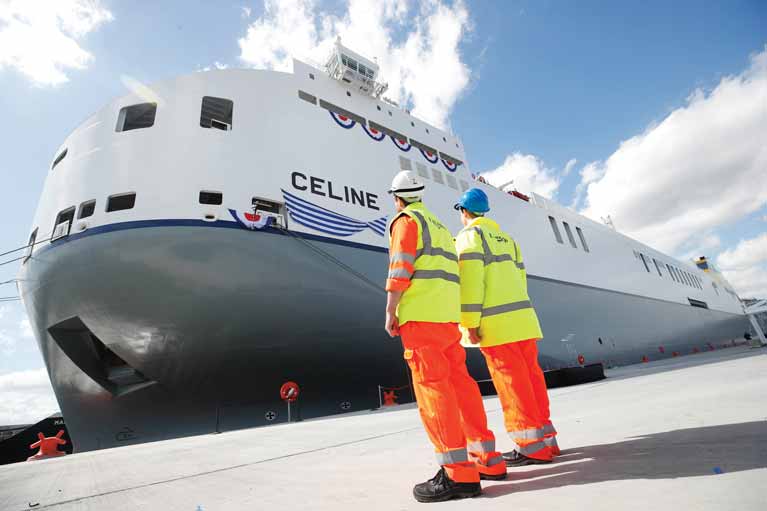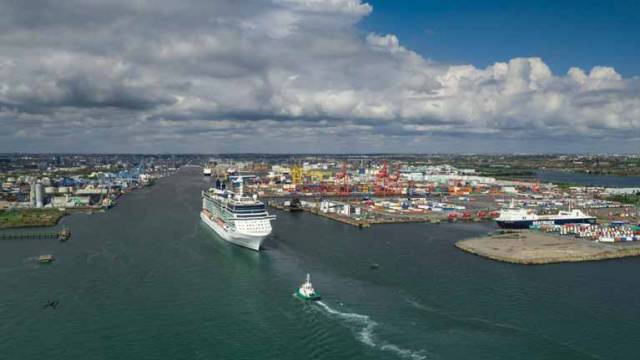As the main gateway for trade in and out of Ireland, 2018 has been a year of exceptional progress and growth at Dublin Port on several fronts
Trade
In the first nine months of the year, cargo volumes rose by 4.7% to 28.4m gross tonnes, with imports up by 6.0% and exports up by 3.0%. Overall, port volumes grew by 4.7% in the period, and by year-end the port will have seen 36% growth in the past six years alone.
Capital Investment
The extraordinary rate of growth requires Dublin Port to accelerate its capital investment programme to deliver the capacity required for future growth. After decades of under-investment in port infrastructure, Dublin Port plans to invest Ä1 billion over the next ten years. In 2018 alone, investment reached Ä132 million, guided by the Masterplan 2040.
Masterplan Reviewed 2018
With record levels of throughput and growth, managing Dublin Port in accordance with the principles of proper planning and sustainable development is key. This year saw the first review of the Masterplan 2012 – 2040 published.
The review has seen Dublin Port’s underlying long-term growth assumption for throughput rise from 2.5% per annum to 3.3% per annum. On this basis, throughput is expected to increase to 77m gross tonnes by 2040 compared to the 60m gross tonnes anticipated when the Masterplan was published initially.
One of the most important outcomes from the review process is a commitment not to expand by way of infill in Dublin Bay, but rather to continue catering for growth in throughput by utilising the existing footprint of the port, both on the North Quays and within the Poolbeg Peninsula together with the additional 44h of lands acquired for Dublin Inland Port.
Brexit
The past year has also been characterised by preparations for Brexit, and work has commenced on primary border control infrastructure in anticipation of the reintroduction of border controls in Dublin Port should that ultimately prove necessary. Dublin Port continues to work in close co-operation with the various State agencies to facilitate what may be required from March 2019.
 Port workers at the MV Celine, the world’s largest short sea Ro-Ro ship owned by CLdN, christened at Dublin Port
Port workers at the MV Celine, the world’s largest short sea Ro-Ro ship owned by CLdN, christened at Dublin Port
New Ships in Port
There were new “faces” on the River in 2018, with the christening of MV Celine, the world’s largest short sea Ro-Ro ship providing additional capacity for customers trading with Continental Europe via the ports of Zeebrugge and Rotterdam. Representing the next generation of super ferries servicing Dublin Port, her arrival also marked a new milestone in the port’s Alexandra Basin Redevelopment (ABR) Project. With a capacity of 8,000 lane-meters, such is her size, MV Celine would not have been able to call into Dublin Port had development works on three kilometres of berths not already commenced.
 Signing on the dotted line for Dublin Port’s new Pilot Boat were: Michael McKenna, Harbour Master, Dublin Port Company, Eamonn O’Reilly, Chief Executive, Dublin Port Company, Alan Goodchild, MD, Goodchild Marine, Steve Pierce, General Manager, Goodchild Marine
Signing on the dotted line for Dublin Port’s new Pilot Boat were: Michael McKenna, Harbour Master, Dublin Port Company, Eamonn O’Reilly, Chief Executive, Dublin Port Company, Alan Goodchild, MD, Goodchild Marine, Steve Pierce, General Manager, Goodchild Marine
With shipping companies increasingly deploying longer, deeper ships, it was announced that the leading UK boat builder Goodchild Marine Services Limited had secured the contract to construct a new Pilot Boat for Dublin Port. The new 17.1 metre ORC vessel is due for delivery to Dublin Port in July 2019 and will be a welcome addition to the fleet required to service the operational needs of the port.
The boat offers several environmental and design features such as greater fuel efficiency, capacity to cut emissions and an ability to handle high speeds in bad weather owing to its innovative beak bow design which can steady the hull as it pitches into the sea. A separate, flexibly mounted wheelhouse will help to mitigate noise and vibration, making the experience for pilots and crew more comfortable, whilst the hull form significantly reduces fuel consumption due to minimal drag.
 Tall Ship Bellem arrives for The Three Festivals Tall Ships Regatta into Dublin Port in June
Tall Ship Bellem arrives for The Three Festivals Tall Ships Regatta into Dublin Port in June
Life on the River
Celebrating life on the River Liffey has been a focal point for Dublin Port in 2018. The Tall Ships Regatta, Poolbeg Yacht Club Regatta, Clontarf Yacht Club Regatta, East Wall Water Sports Regatta, All in a Row charity event, Dublin Currach Regatta, St. Patrick’s Rowing Club Regatta, Stella Maris Rowing Club Regatta, the Hope Row, the “Three Bridges” Liffey Cruise and the Liffey Swim were among the many highlights that saw the River Liffey and Dublin Bay come to life for the sailing community, bringing together those who enjoy this spectacular amenity for recreation, sporting and spectating purposes.
 Lar Joye, Port Heritage Director
Lar Joye, Port Heritage Director
New Resources
Shining a light on the 300-year-old history of Dublin Port and those who worked there is Lar Joye, who took up the new role of Port Heritage Director during the year. Dublin Port’s archive collection covers the history of the port since 1706, and consists of a priceless collection of maps, museum collections, a vast drawings collection, and the paper archive of the Port. The process of bringing the archives into the public domain has begun, with Lar already working on the photograph collection, preparing 18,000 photographs to be digitised during the year and developing a new online resource here
Looking Back
It was also a year to remember events of the past, including the centenary of the sinking of the mailboat RMS Leinster with support for a new art exhibition at the National Maritime Museum of Ireland, Dun Laoghaire, as well as hosting a lecture series to mark the bicentenary of Bullock Harbour.
 Rinn Voyager launch (from left) Dublin Port Company Harbour Master Michael McKenna and Lord Mayor of Dublin Nial Ring join Poolbeg Training CLG Manager Denis Murphy, Betty Ashe of Pearse Street, Tim Darmody of the Docklands and Jimmy Murray of Ringsend
Rinn Voyager launch (from left) Dublin Port Company Harbour Master Michael McKenna and Lord Mayor of Dublin Nial Ring join Poolbeg Training CLG Manager Denis Murphy, Betty Ashe of Pearse Street, Tim Darmody of the Docklands and Jimmy Murray of Ringsend
Notable milestones during the year also included 25 years of the Rinn Voyager Sailing Project, which Dublin Port helped to establish in response to feedback from the local community for educational training facilities and opportunities. The Rinn Voyager Sailing Project began in 1993 when Dublin Port Company agreed to match EU funding and supply the premises, facilities and engineering expertise to help launch an initiative enabling unskilled school leavers and long-term unemployed people from Regal House, Dublin, to build the vessel.
Launched by the then Irish President, Mary Robinson, the Rinn Voyager has been used to great success by countless local community groups and organisations for outings, rehabilitative programmes and team building exercises through the medium of sail training.































































